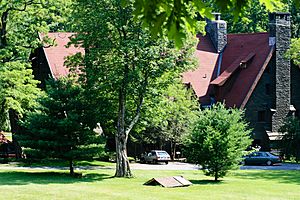Zen Mountain Monastery facts for kids
Quick facts for kids Zen Mountain Monastery |
|
|---|---|
 |
|
| Religion | |
| Affiliation | Mountains and Rivers Order (Zen) |
| Location | |
| Location | P.O. Box 197 Mount Tremper, New York 12457 |
| Country | United States |
| Architecture | |
| Founder | John Daido Loori |
| Completed | 1980 |
| Website | |
| Zen Mountain Monastery | |
|
Camp Wapanachki
|
|
| Location | S. Plank Rd. (Old Co. Rt 28) at jct. with Miller Rd., Shandaken, Mt. Tremper, New York |
| Area | 235 acres (95 ha) |
| Built | 1935 |
| Architect | Haffner, V.L.S. |
| NRHP reference No. | 94001372 |
| Added to NRHP | November 25, 1994 |
Zen Mountain Monastery (also called Doshinji, which means "Temple of the Way of Reality") is a special place for Zen Buddhist training. It is located on a large, forested property in the Catskill Mountains in Mount Tremper, New York.
This monastery was started in 1980 by John Daido Loori. He first called it the Zen Arts Center. The monastery teaches a mix of two Zen traditions: Rinzai and Sōtō. Loori himself learned and was given permission to teach in both traditions.
After Loori passed away in 2009, the monastery was led by two teachers. Since 2015, Shugen Roshi has been the main teacher. He is helped by other teachers like Ron Hogen Green, Sensei, and Jody Hojin Kimmel, Sensei.
Contents
A Historic Building
The main building of the monastery has an interesting past. It was originally built in the 1930s as Camp Wapanachki. This camp was a retreat house and chapel.
The building has a unique style called Arts and Crafts. It is made of stone and wood. It was built in two main parts between 1935 and 1938.
Main House Details
The oldest part is a four-story "main house." This section has living areas, libraries, and a large kitchen. It was designed for people to live and study there.
Dining Hall and Chapel
The newer part of the building is made of a blue-gray stone called bluestone. This section includes a dining hall where people eat together. It also has a chapel, which is a special room for prayer and meditation.
Because of its history and unique style, the building was added to the National Register of Historic Places in 1994. This means it is recognized as an important historical site.
Zen Training and Practice
Students and people living at the monastery follow a special training plan. It is called the Eight Gates of Zen. This plan was created by Daido Roshi.
Eight Gates of Zen
The Eight Gates help people learn and grow in their Zen practice. They include:
- Zazen: This is a type of seated meditation.
- Face-to-face teaching: Students meet directly with teachers.
- Liturgy: This involves chanting and ceremonies.
- Moral and ethical teachings: Learning how to live a good life.
- Work practice: Doing everyday tasks mindfully.
- Body practice: Physical exercises like qigong.
- Art practice: Expressing oneself through art.
- Academic study: Reading and learning about Zen.
People can practice Zen at home or visit the monastery. They can attend weekend retreats or longer meditation sessions called sesshin. The monastery also has a Sunday morning program open to everyone.
Special Programs and Resources
The monastery offers many different programs. These include workshops on painting, poetry, and Japanese archery (kyūdō). They also have classes on playing the shakuhachi, a Japanese flute.
The monastery grounds are also home to other important groups. The Zen Environmental Studies Institute focuses on nature and the environment. Dharma Communications runs The Monastery Store. It also publishes Mountain Record: The Zen Practitioner's Journal. This journal shares articles and teachings about Zen.
Monastic Life
Some people at the monastery are "monastics." This means they have made special promises. They promise to live simply and serve others. They dedicate their lives to following the Buddha's Way. Monastics do not work outside the monastery or earn money. They depend on the support of the community. They help maintain the monastery for everyone.
Mountains and Rivers Order
Zen Mountain Monastery is the main center for the Mountains and Rivers Order. This is a larger group inspired by the teachings of Dogen. John Daido Loori started this order in 1980.
Branches of the Order
The Mountains and Rivers Order includes several different branches:
- Dharma Communications: This group provides teachings and supplies for people practicing Zen at home. It also publishes the Mountain Record, which is a long-running Zen journal.
- Society of Mountains and Rivers: This includes smaller Zen groups in different cities. These groups meet weekly and sometimes have visits from the teachers.
- National Buddhist Archives: This project collects and saves important documents and media. It helps record the history of Buddhism in America.
- Zen Environmental Studies Institute: This group organizes wilderness retreats. They also teach about being mindful of the environment.
- National Buddhist Prison Sangha: This program provides teaching materials and meditation opportunities for people in prison.
- Fire Lotus Temple: This is a Zen training center in New York City. It offers daily training for people who live outside the monastery. Shugen Arnold is the abbot (head teacher) of this temple.
Gallery













